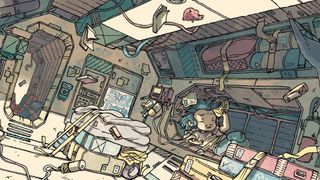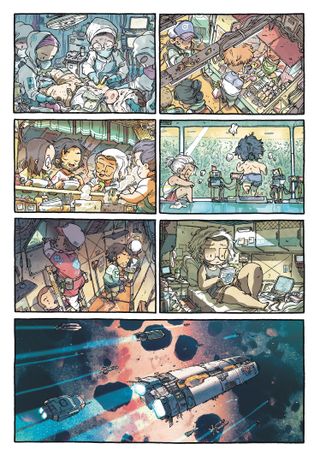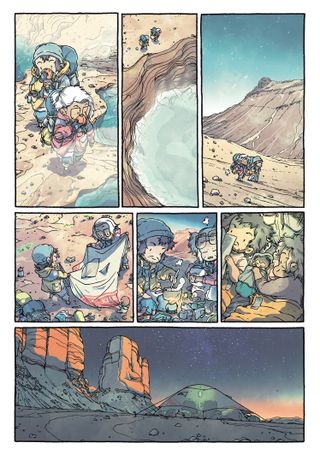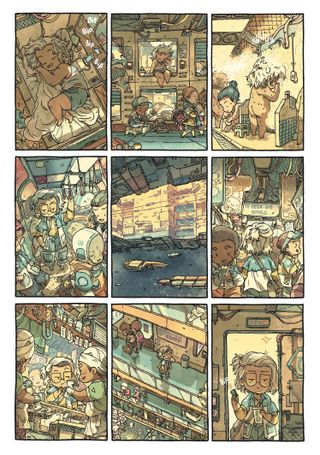Frontier is a stunning new sci-fi graphic novel from Citizen Sleeper artist Guillaume Singelin
Interview | The writer/artist discusses his new project

Guillaume Singelin is the artistic genius who designed the visuals for acclaimed RPG Citizen Sleeper, a game we absolutely loved on its release last year. His gorgeous, manga-inspired designs have a really unique and characterful look that's both cartoony and highly technical. We were very excited to learn, then, that he has a new graphic novel on the way.
Frontier is an original science fiction adventure that follows engineer Ji-Soo as she ventures into space for the very first time. Pushed out of the project that she pioneered, Ji-Soo finds herself on an asteroid mining colony where she makes new friends but also discovers just how tough life amongst the stars can be.
Published by Magnetic Press, Frontier has passed its initial Kickstarter goals many times over and will be blasting off to print in early 2024 in an array of appealing physical editions.
We've got a preview of pages from the book below that will give you a flavor of the beautiful universe that Singelin has created. But first, here is Guillaume to answer a few of our questions about the exciting new project.

Newsarama: Where did the idea for Frontier first come from?
Guillaume Singelin: I've always loved science fiction, ever since Alien and my discovery of Dune, but I couldn't see myself making it into comics. Then creator Mathieu Bablet, who is a very good friend, released Shangri-La and Carbon and Silicon, which really motivated me to embark on a story that takes place in space. The idea was to have a trio of characters who would each show a side of a colonized space world.
What can you tell us about your hero, Ji-Soo? Who is she and what does she want?
Comic deals, prizes and latest news
Get the best comic news, insights, opinions, analysis and more!
GS: Ji-Soo is the first character I created. She is a scientist passionate about the stars, she has this dreamy look at space, one of discovery, science and history. But she is overtaken by reality because in this capitalist world, we don't need a dreamer. Her goal is destroyed and she will have to live with it and perhaps rebuild herself.

What challenges does Ji-Soo face in Frontier?
GS: Ji-Soo has a defiant character, even after the story begins, when the company that hires her does everything to put her on the shelf. Despite that she remains a rebel who always has her dreams. Her biggest challenge is having to overcome her anger, her hatred, and her resentment to move towards something optimistic and beneficial for her.
You've previously described the outlook of the book as "positive", despite the setbacks Ji-Soo faces. In what way?
GS: In the sense that the universe where the story takes place is not in the grip of a great catastrophe, an interstellar war or a creature that thirsts for blood as we see in many stories. The situation isn't necessarily glorious, but it leaves room for the protagonists to see a glimmer of hope or a reason to stay optimistic and fight. I would say that it is more the characters that are positive than the story itself. This trio wants to be more than just a cog in the system. They want a more serene and equitable life and there may be room for that in this universe.

Do you hope Frontier will spark an interest in science in your audience?
GS: Yes of course, I think that any work which is satisfying must give this desire for curiosity, as I felt personally. I'm actually very happy when French readers tell me they don't like sci-fi, but that they tried and liked Frontier and that they will perhaps continue to dig into this genre. A story should be a door to many other areas.
How long have you been working on Frontier?
GS: The idea has been bouncing around in my head for about ten years. Not in a conscious and direct way of course, but since then I have loved drawing little cosmonauts in my sketchbooks. More precisely, the book itself it took around three years to create.









What were your artistic inspirations for this project?
GS: They are very broad, but for Frontier, my love of Japanese RPGs played a big role, particularly in relation to the artist Akihiko Yoshida, but also the manga Planetes by Makoto Yukimura.
What do you most enjoy about science fiction as a genre?
GS: The ability to talk about subjects that are close to us, while putting a distance to be able to exacerbate them but also take some liberties. Also I love drawing ships and space suits. I am fascinated by documentaries on space, and there is a very strong graphic richness between the complexity of structures, clothing and at the same time the emptiness of space. This contrast is fascinating to me.
Frontier is available in three physical editions: a trade paperback, a Kickstarter-exclusive premium hardcover, and a slipcase bundle (limited to 250 copies) that also includes a numbered bookplate signed by Singelin, an etched metal "traveler ticket" bookmark, an exclusive 75mm 3D-printed statuette of one of the characters, and a 2" metal currency token. Orders will be fulfilled in April 2024.
Some of the most iconic video games have amazing comic book adaptations. Find out about them here.

Will Salmon is the Comics Editor for GamesRadar/Newsarama. He has been writing about comics, film, TV, and music for more than 15 years, which is quite a long time if you stop and think about it. At Future he has previously launched scary movie magazine Horrorville, relaunched Comic Heroes, and has written for every issue of SFX magazine for over a decade. He sometimes feels very old, like Guy Pearce in Prometheus. His music writing has appeared in The Quietus, MOJO, Electronic Sound, Clash, and loads of other places and he runs the micro-label Modern Aviation, which puts out experimental music on cassette tape.
Most Popular





